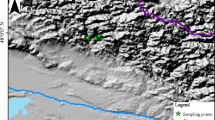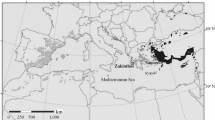Abstract
Data on the seasonal development of 78 species of perennial plants in the forest-steppe conditions of Western Siberia have been generalized over a 20-year period (1996–2015) due to changes in the regional climate. It is demonstrated that the meteorological parameters of the warm season of the year in Novosibirsk have undergone significant changes: the average daily air temperature has increased by 0.16°C, the growing season has lengthened by 12 days, and the active vegetation period of plants at temperatures above 10°C has lengthened by 8 days. The correlations of the time of regrowth phenophases and the beginning of flowering of perennials with the data of snow-cover disappearance, dates of transition of average daily air temperatures through 5 and 10°С upward, and sums of these temperatures are detected. Using linear phenological trends, a delay within 2–6 days of the beginning of the vegetation and the advanced beginning of flowering (except for early summer species) by 2–10 days are established. Shortening the duration of prefloral period from 5 to 24 days indicates an acceleration in the rate of the development of perennials against the background of the detected meteorological trends. A change in the duration of vegetation is significant in spring–autumn green and spring–summer–winter green species (10 and 12 days, respectively). Low values of determination coefficient for most trends R2 < 0.06 demonstrated that changes in the phenology of species are mainly caused by interannual variability.



Similar content being viewed by others
Notes
https://rp5.ru/Архив_погоды_в_Огурцово.
REFERENCES
Ausin, I., Alonso-Blanco, C., and Martinez-Zapater, J.M., Environmental regulation of flowering, Int. J. Dev. Biol., 2005, vol. 49, pp. 689–705. https://doi.org/10.1387/ijdb.052022ia
Badeck, F.-W., Bondeau, A., Böttcher, K., Doktor, D., Lucht, W., Schaber, J., and Sitch, S., Responses of spring phenology to climate change, New Phytol., 2004, vol. 162, pp. 295–309. https://doi.org/10.1111/j.1469-8137.2004.01059.x
Bertin, R.I., Plant phenology and distribution in relation to recent climate change, J. Torrey Bot. Soc., 2008, vol. 135, no. 1, pp. 126–146. https://doi.org/10.3159/07-RP-035R.1
Chmielewski, F.-M., Phenology in agriculture and horticulture, in Phenology: An Integrative Environmental Science, Schwartz, M.D., Eds., New York: Springer-Verlag, 2013, pp. 539–561. https://doi.org/10.1007/978-94-007-6925-0_29
Chmura, H.E., Kharouba, H.M., Ashander, J., Ehlman, S.M., Rivest, E.B., and Yang, L.H., The mechanisms of phenology: The patterns and processes of phenological shifts, Ecol. Monogr., 2019, vol. 89, no. 1, p. e01337. https://doi.org/10.1002/ecm.1337
Cleland, E.E., Chuine, I., Menzel, A., Mooney, H.A., and Schwartz, M.D., Shifting plant phenology in response to global change, Trends Ecol. Evol., 2007, vol. 22, no. 7, pp. 357–365. https://doi.org/10.1016/j.tree.2007.04.003
Efron, B., Bootstrap methods: Another look at the jackknife, Ann. Stat., 1979, vol. 7, no. 1, pp. 1–26. https://doi.org/10.1214/aos/1176344552
England, M.H., McGregor, S., Spence, P., Meehl, G.A., Timmermann, A., Cai, W., Gupta, A.S., McPhaden, M.J., Purich, A., and Santoso, A., Recent intensification of wind-driven circulation in the Pacific and the ongoing warming hiatus, Nat. Clim. Change, 2014, vol. 4, pp. 222–227. https://doi.org/10.1038/nclimate2106
Fomina, T.I., Biologicheskie osobennosti dekorativnykh rastenii prirodnoi flory v Zapadnoi Sibiri (Biological Characteristics of Ornamental Plants of Natural Flora in Western Siberia), Novosibirsk: GEO, 2012.
Forrest, J. and Miller-Rushing, A.J., Toward a synthetic understanding of the role of phenology in ecology and evolution, Phil. Trans. R. Soc. B, 2010, vol. 365, pp. 3101–3112. https://doi.org/10.1098/rstb.2010.0145
Franks, S.J., Weber, J.J., and Aitken, S.N., Evolutionary and plastic responses to climate change in terrestrial plant populations, Evol. Appl., 2013, vol. 7, no. 1, pp. 123–139. https://doi.org/10.1111/eva.12112
Gordo, O. and Sanz, J., Impact of climate change on plant phenology in Mediterranean ecosystems, Global Change Biol., 2010, vol. 16, pp. 1082–1106. https://doi.org/10.1111/j.1365-2486.2009.02084.x
Gratani, L., Plant phenotypic plasticity in response to environmental factors, Adv. Bot., 2014, vol. 2014, artic. ID 208747. https://doi.org/10.1155/2014/208747
Hunter, M.C., Using ecological theory to guide urban planting design: An adaptation strategy for climate change, Landscape J., 2011, vol. 30, pp. 2–11.
Ibáñez, I., Primack, R.B., Ellwood, E., Miller-Rushing, A.J., Higuchi, H., Lee, S.D., Kobori, H., and Silander, J.A., Forecasting phenology under global warming, Phil. Trans. R. Soc. B, 2010, vol. 365, no. 1555, pp. 3247–3260. https://doi.org/10.1098/rstb.2010.0120
IPCC, 2014: Climate Change 2014: Synthesis Report. Contribution of Working Groups I, II and III to the Fifth Assessment Report of the Intergovernmental Panel on Climate Change, Pachauri, R.K. and Meyer, L.A., Eds., Geneva: IPCC, 2014.
Jeong, S.J., Ho, C.H., Gim, H.J., and Brown, M.E., Phenology shifts at start vs. end of growing season in temperate vegetation over the Northern Hemisphere for the period 1982–2008, Global Change Biol., 2011, vol. 17, pp. 2385–2399. https://doi.org/10.1111/j.1365-2486.2011.02397.x
Khanduri, V.P., Sharma, C.M., and Singh, S.P., The effects of climate change on plant phenology, Environmentalist, 2008, vol. 28, pp. 143–147. https://doi.org/10.1007/s10669-007-9153-1
Koterov, A.N., Ushenkova, L.N., Zubenkova, E.S., Kalinina, M.V., Biryukov, A.P., Lastochkina, E.M., Molodtsova, D.V., and Vainson, A.A., The strength of the connection. Message 2. Gradations of the correlation value, Med. Radiol. Radiats. Bezop., 2019, vol. 64, no. 6. https://doi.org/10.12737/1024-6177-2019-64-6-12-24
Lippmann, R., Babben, S., Menger, A., Delker, C., and Quint, M., Development of wild and cultivated plants under global warming conditions, Curr. Biol., 2019, vol. 29, pp. R1326–R1338. https://doi.org/10.1016/j.cub.2019.10.016
Luchitskaya, I.O., Belaya, N.I., and Arbuzov, S.A., Klimat Novosibirska i ego izmeneniya (Climate of Novosibirsk and Its Changes), Yagudin, R.A., Ed., Novosibirsk: Sib. Otd. Ross. Akad. Nauk, 2014.
McDonough MacKenzie, C., Gallinat, A.S., and Zipf, L., Low-cost observations and experiments return a high value in plant phenology research, Appl. Plant Sci., 2020, vol. 8, no. 4. e11338. https://doi.org/10.1002/aps3.11338
Miller-Rushing, A.J., Inouye, D.W., and Primack, R.B., How well do first flowering dates measure plant responses to climate change? The effects of population size and sampling, J. Ecol., 2008, vol. 96, pp. 1289–1296. https://doi.org/10.1111/j.1365-2745.2008.01436.x
Nauchno-prikladnoi spravochnik po klimatu SSSR (Scientific and Applied Reference Book on the Climate of the USSR), Ser. 3: Mnogoletnie dannye (Long-Term Data), St. Petersburg: Gidrometeoizdat, 1993, parts 1–6, no. 20.
Park, I., Jones, A., and Mazer, S.J., PhenoForecaster: A software package for the prediction of flowering phenology, Appl. Plant Sci., 2019, vol. 7, no. 3, p. e1230. https://doi.org/10.1002/aps3.1230
Parmesan, C. and Yohe, G., A globally coherent fingerprint of climate change impacts across natural systems, Nature, 2003, vol. 421, pp. 37–42. https://doi.org/10.1038/nature01286
Peñuelas, J., Rutishauser, T., and Filella, I., Phenology feedbacks on climate change, Science, 2009, vol. 324. https://doi.org/10.1126/science.1173004
Primack, R.B. and Miller-Rushing, A.J., Broadening the study of phenology and climate change, New Phytol., 2011, vol. 191, pp. 307–309.
Rai, P.K., A concise review on multifaceted impacts of climate change on plant phenology, Environ. Skeptics Crit., 2015, vol. 4, no. 4, pp. 106–115.
Rathcke, B. and Lacey, E.P., Phenological patterns of terrestrial plants, Annu. Rev. Ecol. Evol. Syst., 1985, vol. 16, pp. 179–214.
Robbirt, K.M., Davy, A.J., Hutchings, M.J., and Roberts, D.L., Validation of biological collections as a source of phenological data for use in climate change studies: A case study with the orchid Ophrys sphegodes, J. Ecol., 2011, vol. 99, pp. 235–241. https://doi.org/10.1111/j.1365-2745.2010.01727.x
Root, T.L., Price, J.T., Hall, K.R., Schneider, S.H., Rosenzweigk, C., and Pounds, J.A., Fingerprints of global warming on wild animals and plants, Nature, 2003, vol. 421, pp. 57–60. https://doi.org/10.1038/nature01333
Shestoe natsional’noe soobshchenie Rossiiskoi Federatsii, predstavlennoe v sootvetstvii so stat’yami 4 i 12 Ramochnoi Konventsii Organizatsii Ob’’edinennykh Natsii ob izmenenii klimata i stat’ei 7 Kiotskogo protokola (The Sixth National Communication of the Russian Federation Submitted in Accordance with Articles 4 and 12 of the United Nations Framework Convention on Climate Change and Article 7 of the Kyoto Protocol), Frolov, A.V., Makosko, A.A., Blinov, V.G., et al., Moscow, 2013.
Singh, K., On the asymptotic accuracy of Efron’s bootstrap, Ann. Stat., 1981, vol. 9, no. 6, pp. 1187–1195. https://doi.org/10.1214/aos/1176345636
Sparks, T.H. and Menzel, A., Observed changes in seasons: An overview, Int. J. Climatol., 2002, vol. 22, pp. 1715–1725. https://doi.org/10.1002/joc.821
Trulevich, N.V., Ekologo-fitotsenoticheskie osnovy introduktsii rastenii (Ecological and Phytocenotic Foundations of Plant Introduction), Moscow: Nauka, 1991.
Voronina, L.V. and Gritsenko, A.G., Klimat i ekologiya Novosibirskoi oblasti (Climate and Ecology of the Novosibirsk Region), Novosibirsk: SGGA, 2011.
Walther, G.-R., Post, E., Convey, P., Menzel, A., Parmesan, C., Beebee, T.J.C., Fromentin, J.-M., Hoegh-Guldberg, O., and Bairlein, F., Ecological responses to recent climate change, Nature, 2002, vol. 416, pp. 389–395.
Wolkovich, E.M., Cook, B.I., and Davies, T.J., Progress towards an interdisciplinary science of plant phenology: Building predictions across space, time and species diversity, New Phytol., 2014, vol. 201, pp. 1156–1162. https://doi.org/10.1111/nph.12599
Zhmyleva, A.P., Karpukhina, E.A., and Zhmylev, P.Yu., Phenological response of forest plants to climate warming: Early and late flowering species, Vestn. Ross. Univ. Druzhby Nar., Ser. Ekol. Bezop. Zhiznedeyatel’nosti, 2011, no. 2, pp. 5–15.
Zorina, A.A., Shuiskaya, E.A., Kurakina, I.V., Volkov, V.P., Ogurtsov, S.S., and Stepanov, S.N., Climatic reasons for the shift in the timing of flowering plants in the Central Forest Reserve, Povolzh. Ekol. Zh., 2020, no. 1, pp. 52–65. https://doi.org/10.35885/1684-7318-2020-1-52-65
ACKNOWLEDGMENTS
Materials of the Bioresource Scientific Collection, Central Siberian Botanical Garden (Siberian Branch, Russian Academy of Sciences), Collection of Living Plants Indoors and Outdoors Unique Scientific Facility (USU 440534) were used in preparing this manuscript.
Funding
This study was performed as part of the state task for project AAAA-A21-121011290025-2 “Estimation of Morphogenetic Potential of Plant Populations of North Asia by Experimental Methods” and within budgetary project no. 0259-2021-0009 “System Biology and Bioinformatics: Reconstruction, Analysis, and Modeling of Structural and Functional Organization and Evolution of Gene Networks of Humans, Animals, Plants, and Microorganisms.”
Author information
Authors and Affiliations
Corresponding authors
Ethics declarations
Conflict of interests. The authors declare that they have no conflicts of interest.
Statement on the welfare of humans or animals. This article does not contain any studies involving humans or animals performed by any of the authors.
Additional information
Translated by A. Barkhash
Rights and permissions
About this article
Cite this article
Fomin, E.S., Fomina, T.I. Changes in the Phenology of Perennial Plants in Western Siberia against the Background of Global Warming. Contemp. Probl. Ecol. 14, 434–445 (2021). https://doi.org/10.1134/S199542552105005X
Received:
Revised:
Accepted:
Published:
Issue Date:
DOI: https://doi.org/10.1134/S199542552105005X




